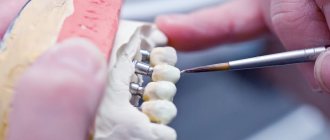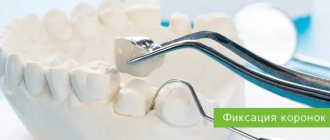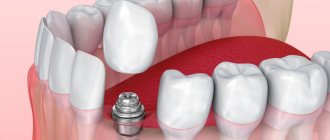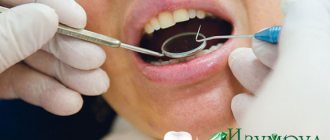Features of a temporary crown on an implant
After implantation, a certain period of time must pass before the permanent crown is placed. Over the course of several months, a specialist monitors the osseointegration of the titanium screw. But walking even for several days with a “space” instead of a tooth is extremely uncomfortable. A temporary crown on an implant made of composite material or plastic will help solve the problem. The design does not interfere with the process of engraftment of the artificial root and creates the necessary load for primary stabilization. Due to the fact that special cement dissolves over time under the influence of salivary enzymes, the temporary crown can easily be replaced with a permanent one at the right time.
What are temporary crowns on implants used for?
In addition to maintaining the aesthetics of your smile, temporary crowns placed on titanium roots perform a number of other useful tasks.
- Preparation of soft tissues for the next stage of implantation.
- Providing psychological comfort.
- Helps in the formation of smooth gum edges.
- Protection against bacteria that can cause gum inflammation and implant rejection.
- Maintaining correct diction and bite.
- Restoration of chewing functions.
- Facilitate adaptation to permanent crowns.
- Creating the correct load to stabilize the implant.
Shaping the gum contour using temporary crowns
With one-stage dental implantation, when a tooth is removed and an implant is immediately installed in its place, a temporary crown (if it can be installed immediately) allows you to preserve the natural contour of the gum around the tooth, preventing the gum from filling the tooth socket.
If it was not possible to immediately install a temporary crown on a dental implant, and the gums have leveled out during the healing of the implant, then temporary crowns help form the correct gingival contour. Let's take a closer look at how this happens.
After the implants have healed, gum formers are screwed into them, which allow access to the implant to be created (sometimes gum formers are installed at the time of dental implantation).
Result after removal of the gum former:
The crown in the lower part has the shape of a cone, so with a special drill or laser the hole from above is expanded to give it a cone-shaped shape, like natural teeth. The expansion is performed under local anesthesia. The advantage of using a laser is that the vessels are immediately sealed and this operation is practically bloodless.
Temporary crowns for implants are made by an orthopedic dentist on the day of the patient’s visit using wax models prepared in advance in the laboratory. A temporary abutment (crown base) is screwed into the implant, and temporary crowns are fixed onto the abutment using temporary cement.
While wearing temporary crowns (about 2 weeks), the gums heal and finally take the desired shape, not only around the crown, but also filling the interdental space (gingival papillae are formed).
Temporary crowns are easily removed, since the fixing composition is not strong (this was done specifically so that the temporary crown can be removed without damaging the implant). If the crown falls off ahead of time, then it must be fixed in place as quickly as possible so as not to disturb the healing of the gums.
Having removed the temporary crowns after 2 weeks, the doctor sees a well-formed bed:
Impressions can now be taken to make permanent crowns that will look perfect from all angles.
While the permanent crowns are being manufactured, temporary crowns are re-installed on the implants.
After the permanent abutments and crowns are made, the temporary structures are removed and the permanent crowns are fixed onto the implants. Thanks to the preparation of the gums, permanent crowns look absolutely natural from all sides.
Without preliminary preparation of the gums, black triangles remain between the teeth, and food gets clogged between the teeth.
Thus, temporary crowns are necessary to create tight contact between the gum and the crown on the implant, which ensures not only aesthetics, but also the health of the gums and the ease of use of the crowns.
What is an abutment
Previously, in dentistry, an abutment was called a supporting structure for bridges. Nowadays this word refers to a small rod that plays an important role as the periosteal element of the implant. A replacement structure for lost teeth is installed on it. The following may serve in this capacity:
- one crown;
- bridge prosthesis;
- removable denture.
That is, the abutment serves as a kind of substitute for an artificial root, twisting on one side into an implant, and on the other into a single dental prosthesis or bridge.
Abutments differ not only in size, but also in the material from which they are made, as well as in shape. Which design is best for a patient will depend on a number of factors and clinical considerations.
For reliable and long-term wearing of artificial teeth, the dentist installs an abutment that matches the characteristics of the implant.
How long can temporary crowns be worn?
Typically, temporary crowns are worn for no more than 2 months. Temporary crowns are made from plastic or composite polymers. These materials are quite porous and not very durable. Long-term wearing of temporary dental crowns is not recommended due to the strong accumulation of bacteria on the surface of the crown, which causes inflammation of the gums, as well as increased abrasion of the material.
Plastic temporary crowns can change color due to the use of coloring products - tea, coffee, red wine, etc.
Temporary crowns that will be worn for longer than 2 months are made from more durable materials.
Types of abutment
There are two main types of design:
- individual;
- standard.
The latter type is characterized by versatility. Standard systems, prepared according to certain patterns, have the advantage of not only low prices, accessible to many patients, but also model variety. The dentist will easily select the desired structure and, if necessary, replace it with another connecting element. Custom designs, which take into account the peculiarities of the anatomy of the human jaw, are superior in cost to factory ones. At the same time, in terms of quality and technical parameters, they are also not inferior to factory ones.
Individual designs have a distinctive feature that is an exact match to the implants. Any errors are excluded here. The latest CAD/CAM technologies are used to manufacture connecting elements. The material, as a rule, for these structures is zirconium, which is characterized by high strength and excellent external parameters.
The designs also differ in functionality:
- Angular. Such structures can be installed at a certain angle; the tilt allows you to give a natural look to the implantation system.
- Globular. Purpose: fixation on miniature implants. In addition, they are used on removable prosthetics.
- Direct. As a rule, they are used to restore the anterior groups of teeth, since the design involves direct fixation.
The cost of abutments depends on both their type and the material from which they are made.
What is it used for?
Such structures serve to shape the gums to the required shape, which is a mandatory component to achieve the required aesthetic appearance. The abutment is a titanium structure with a screw shaft. In this case, installing an abutment directly into the gum is unacceptable. The dimensions of the temporary structure and its angle of inclination depend on the type of dental crown and the method of fixation.
Also, the dimensions of the abutment and its design should adjust the shape of the gums so as not to disrupt all bioprocesses in it.
Life time.
As has already become clear, this device is intended only for a short period of use and for the purpose of replacing a cosmetic defect and restoring the functionality of the jaw. Typically, plastic products last no more than 6 months, and composite ones up to a year. Therefore, you are unlikely to be able to extend the shelf life of the “caps”, and if you do not follow the operating rules, you risk reducing it altogether. When wearing crowns for a long time, their surface wears off, which is why neighboring healthy teeth begin to shift towards the ground unit, and the aesthetics of artificial systems leaves much to be desired. It is not recommended to delay the next stage of prosthetics, and as soon as the main onlay is ready, replace it.
What to do if the crown falls out.
As mentioned earlier, the crown may fall out, this is due to a number of factors, but the main reason is the adhesive, which is prone to dissolution. Because the overlay is assigned only temporarily; a specialist cannot fix it on a permanent basis. It does not fit tightly enough to the surface of the tooth, so it can slip off. In this case, you cannot try to return it to its original place yourself using improvised means. For example, plasticine, toothpaste or household glue. Not only will you damage the crown, but you will also cause serious harm to the ground molars and incisors. If this happens to you, it is recommended to do the following:
- First, call your doctor and explain the situation, make an appointment for correction.
- If your dentist cannot help you at the moment, rinse the crown and carefully place it back in your mouth (without using any aids, of course). Even in this form, it can at least somehow protect your tooth. When eating and before going to bed, you need to put it in a glass of warm water, continue these techniques until your visit to the doctor, and if it drags on, contact another specialist.
Important! Do not ignore this problem and resolve it as soon as possible. In the worst case, the infection will get into the pulp of the tooth and it will become inflamed, which may lead to its removal.
How does the installation work?
Direct method
The dentist takes an impression using silicone paste. He pours a special solution into it and puts it all on the implant. After the composition has completely cooled, the impression is removed, and the temporary crown remains in the oral cavity. To make it look aesthetically pleasing, the dentist gives the crown an anatomically correct shape: polishes, grinds and fixes it with cement.
pros:
- production speed - about 1 hour,
- aesthetics.
Minuses:
- fragility,
- fragility.
Indirect method
The temporary crown is made in a dental laboratory. For this, a plaster model taken from both jaws is used. The total production time for a structure using the indirect method is 2-3 days. Before installation, it is carefully sanded and polished. For fixation, special cement or screw fastening is used.
pros:
- strength,
- durability,
- taking into account the individual characteristics of each patient.
Minuses:
- produced within 2-3 days.
Which material is better to choose from?
The choice of material depends on the design features of the future prosthesis, as well as on the financial capabilities of the patient.
Titanium
It is used both in the manufacture of implants and abutments. Durability, reliability, high compatibility with the human body. Perfectly withstands loads when installed on molars. The only disadvantage of this material, but quite significant, is the transparency through the crown. Therefore, it is not suitable for front teeth.
Zirconium
It is not popular with most patients. The reason for this lies not in the quality, but in the high price of zirconium dioxide. This material has many advantages - there is no translucency through the crown, like with titanium structures, it is very durable and non-allergenic.
Combined
Combination of several advantages of materials. The design, endowed with the advantages of, for example, zirconium and titanium, has both super strength and beautiful appearance. At the same time, she is expensive.
Plastic
The material, accessible to the majority, cannot but attract the masses. But it is unlikely to be suitable as a permanent structure, only as a temporary gum former.
When choosing, clinical and individual factors are also taken into account:
- distance to the implant from antagonist teeth;
- thickness of the mucous membrane;
- screw or cement fixation of the prosthesis.
The dentist evaluates these factors, as well as the patient’s wishes regarding the aesthetic side, and makes a decision on choosing an abutment for the implant.
Possible complications
Sometimes complications arise even after short-term use of temporary prostheses. The most common of them are:
- Rubbing of soft gum tissue.
- Inflammation of the gums.
- Stomatitis. Prosthetic stomatitis occurs when the structure fits too tightly to the gum. The product puts pressure on the gum, disrupting the blood flow in it. Thus, the tissue begins to die. To eliminate this problem, it is necessary to rinse the mouth with an antiseptic and hydrogen peroxide.
- If there is a lot of free space between the denture and the gum, then food can get into it, accumulate there, rot and cause caries. However, with regular, careful hygiene, caries can be avoided.
- In some cases, patients experience allergic reactions to prosthetic materials or auxiliary materials used in prosthetics. This situation is unpredictable, since the causes of allergies have not yet been identified. Typically, an allergic reaction manifests itself in the form of an asthma attack, the appearance of a rash, burning sensation, and the formation of plaque on the tongue.
- The appearance of pain. Normally, there should be no discomfort. If they appear, it means the prosthesis was not made accurately.
- Change in the volume of saliva secreted. If saliva begins to be released in a larger or smaller volume, then we can talk about a medical error.
Typically, such complications arise due to the unprofessionalism of the attending physician and dental technician. Also, each patient’s body is unique and may give an unexpected reaction. To facilitate the process of getting used to a new object in the oral cavity, you can perform a massage. You should hold the denture with one finger and rub the other finger along the gum with a massaging motion, pressing lightly. A specialist will tell you more about the massage technique after installing the prosthesis.
Regardless of the nature of the complications, if they occur, you should immediately consult your doctor. The specialist will remove the denture from the mouth and replace the construction material.
The duration of the adaptation period is different for all patients and depends on the individual characteristics of the body. Sometimes a person does not feel the prosthesis in his mouth after 2 hours. But in some cases, patients cannot adapt to removable dentures at all.
How much does it cost on average in Moscow?
| Name of service | Cost, rub. |
| Installation of the healing abutment | 3700 |
| Installation of a temporary abutment | |
| Standard | 4600 |
| Individual | 9400 |
| Temporary abutment by manufacturer (without dental services) | |
| Implantium | 1000 |
| Alpha Bio | 1050 |
| BioHorizons | 1050 |
| M.I.S. | 1400 |
| Osstem | 1800 |
| Xive | 1900 |
| Nobel Biocare | 2000 |
| Ankylos | 2400 |
Discomfort and possible complications after installation
A complication in the form of inflammation of soft tissues can occur after surgery to install implants, that is, they relate to the period after implantation. With the classical approach, the installation of supporting elements is carried out after complete engraftment of analogues of living roots, so there should be no complications here. If the elements are installed immediately, then unpleasant and dangerous consequences may arise.
You should consult a doctor if, a week after the operation, swelling of the soft tissues does not subside, there is increasing pain, and fluid/blood/pus is released from the gums around the operation area. All these manifestations can signal inflammation of the soft tissues and subsequent implant rejection. The reason is a violation of asepsis during procedures, poor oral hygiene during the rehabilitation period, infection of soft tissues due to a violation of the tightness of the connection due to unreliable fixation.
In the “implant-abutment-prosthesis” connection, each element of the system is equally important. So, if the implant and superstructure are installed correctly, but the artificial crown is made in violation of technical regulations and does not correspond to the characteristics of the patient’s bite, then because of this it can transfer an increased load to the implant, which will disable it.
Also, a frequent complication of incorrect installation is the formation of gingival growths around the superstructure, which greatly affects the aesthetics of the smile. If such a situation occurs, then you need to consult a doctor who will perform gum surgery and remove excess tissue.
%akc54%
Models of temporary abutments from various manufacturers
Alpha Bio:
Produced in three versions:
- With a standard platform that fits any implant model, length options from 2 to 7 mm.
- With thin platform for internal hex implants, length options from 3 to 5 mm.
- With a wide platform for implants with a diameter of 5 and 6 mm, length options from 3-5 mm.
Features of Alpha Bio superstructures for temporary restoration:
- suitable for installation with or without loading a temporary prosthesis;
- used for screw fixation;
- the ability to modify the shape of the abutment at any stage;
- the biocompatibility of the material eliminates the risk of allergic reactions;
- high resistance to chewing load;
- the design tolerates sterilization by autoclaving without loss of functionality;
- The line includes straight and angular models.
Nobel Biocare:
- a variety of superstructures allows you to select the load required for any protocol;
- Carbon-coated TorqTite screws provide strong stabilization;
- All standard abutments come with a lifetime warranty.
Ankylos:
- made of polycrystalline high-temperature polymer reinforced with cubic zirconia;
- The line contains one-component and two-component models with a separate screw.
Mis:
- all samples are designed for long-term use, up to 8 months;
- the beige color does not show through the crown, which makes the restoration highly aesthetic;
- can be used to create a custom shaper.
Xive:
- Temp Base abutment models allow prosthetics to be performed immediately after implantation within 5 minutes, which is important for temporary restoration of the anterior region;
- Pre-assembled design allows for quick installation.
Bio Horizons:
- the Laser-Lok model suppresses epithelial growth in the apical part, providing excellent conditions for prosthetics;
- if it is necessary to take impressions, the structure can be removed and then reinstalled;
- valid for up to 30 days.
Osstem:
- used for immediate loading;
- has a titanium platform, which gives the product strength;
- service life up to 180 days.
Proper care
After placing a temporary crown, there are several restrictions that must be observed. This will ensure the durability of the structure. 5 recommendations that will make your care of temporary crowns correct:
- Avoid too hard foods (crackers, hard apples, nuts, etc.).
- Try not to place too much stress on the side where the implant was placed.
- When brushing your teeth, do not press the toothbrush onto the crown.
- Use dental floss with caution.
- Visit your dentist promptly (for example, if the temporary crown begins to loosen).
For implantation to take place quickly, efficiently and safely, contact professionals. The specialists of the dental clinic “V Put” are ready to cope with a task of any complexity. By contacting us, you make a choice in favor of quality and health!











